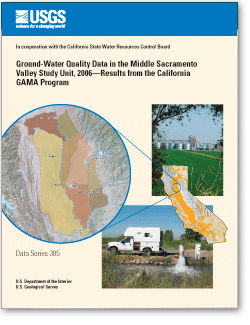 ABSTRACT
ABSTRACT
Ground-water quality in the approximately 3,340 mi2 Middle Sacramento Valley study unit (MSACV) was investigated from June through September, 2006, as part of the California Groundwater Ambient Monitoring and Assessment (GAMA) program. The GAMA Priority Basin Assessment project was developed in response to the Groundwater Quality Monitoring Act of 2001 and is being conducted by the U.S. Geological Survey (USGS) in cooperation with the California State Water Resources Control Board (SWRCB).
The Middle Sacramento Valley study was designed to provide a spatially unbiased assessment of raw ground-water quality within MSACV, as well as a statistically consistent basis for comparing water quality throughout California. Samples were collected from 108 wells in Butte, Colusa, Glenn, Sutter, Tehama, Yolo, and Yuba Counties. Seventy-one wells were selected using a randomized grid-based method to provide statistical representation of the study unit (grid wells), 15 wells were selected to evaluate changes in water chemistry along ground-water flow paths (flow-path wells), and 22 were shallow monitoring wells selected to assess the effects of rice agriculture, a major land use in the study unit, on ground-water chemistry (RICE wells).
The ground-water samples were analyzed for a large number of synthetic organic constituents (volatile organic compounds [VOCs], gasoline oxygenates and degradates, pesticides and pesticide degradates, and pharmaceutical compounds), constituents of special interest (perchlorate, N-nitrosodimethylamine [NDMA], and 1,2,3-trichloropropane [1,2,3-TCP]), inorganic constituents (nutrients, major and minor ions, and trace elements), radioactive constituents, and microbial indicators. Naturally occurring isotopes (tritium, and carbon-14, and stable isotopes of hydrogen, oxygen, nitrogen, and carbon), and dissolved noble gases also were measured to help identify the sources and ages of the sampled ground water.
Quality-control samples (blanks, replicates, laboratory matrix spikes) were collected at approximately 10 percent of the wells, and the results for these samples were used to evaluate the quality of the data for the ground-water samples. Field blanks rarely contained detectable concentrations of any constituent, suggesting that contamination was not a noticeable source of bias in the data for the ground-water samples. Differences between replicate samples were within acceptable ranges, indicating acceptably low variability. Matrix spike recoveries were within acceptable ranges for most constituents.
This study did not attempt to evaluate the quality of water delivered to consumers; after withdrawal from the ground, water typically is treated, disinfected, or blended with other waters to maintain acceptable water quality. Regulatory thresholds apply to treated water that is served to the consumer, not to raw ground water. However, to provide some context for the results, concentrations of constituents measured in the raw ground water were compared with health-based thresholds established by the U.S. Environmental Protection Agency (USEPA) and California Department of Public Health (CDPH) and thresholds established for aesthetic concerns (secondary maximum contaminant levels, SMCL-CA) by CDPH. Comparisons between data collected for this study and drinking-water thresholds are for illustrative purposes only and are not indicative of compliance or noncompliance with regulatory thresholds.
Most constituents that were detected in ground-water samples were found at concentrations below drinking-water thresholds. VOCs were detected in less than one-third and pesticides and pesticide degradates in just over one-half of the grid wells, and all detections of these constituents in samples from all wells of the MSACV study unit were below health-based thresholds. All detections of trace elements in samples from MSACV grid wells were below health-based thresholds, with the exceptions of arsenic and boron.
Arsenic concentrations were above the USEPA maximum contaminant level (MCL-US) threshold in eight grid wells, and boron concentrations were above the CDPH notification level (NL-CA) in two grid wells. Arsenic was detected above the MCL-US in two flow-path wells. Arsenic, barium, boron, molybdenum, strontium, and vanadium were detected above health-based thresholds in a few of the RICE wells; these wells are not used to supply drinking water. All detections of radioactive constituents were below health-based thresholds, although six samples had activities of radon-222 above the lower proposed MCL-US threshold. Most of the samples from the MSACV wells had concentrations of major elements, total dissolved solids, and trace elements below the non-enforceable thresholds set for aesthetic concerns. Chloride and sulfate concentrations exceeded SMCL-CA thresholds in two and one grid well, respectively. Iron, manganese, and total dissolved solids concentrations were above the SMCL-CA thresholds in 1, 12, and 6 grid wells, respectively. Nitrate (nitrite plus nitrate, as dissolved nitrogen) concentrations from two grid wells were above the MCL-US threshold. There were no detections of microbial indicators in MSACV.